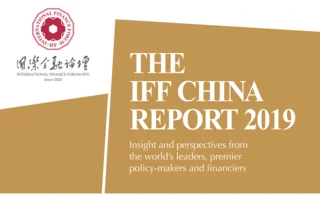
Fintech – The first financial revolution


Two interesting and important reports were published on the topic of financial technology – known as fintech – in 2018: the Global fintech hub index 2018 by the Academy of Internet Finance, Zhejiang University, and the 2018 Fintech100 by KPMG.
KPMG’s report indicated three of the five top global fintech companies originated in China, with Ant Financial in first place, JD Finance in second and Du Xiaoman Financial – which recently split from parent company Baidu – in fourth.

Zhejiang University’s Academy of Internet Finance research established that the Yangtze River Delta – comprising Shanghai, Hangzhou and Nanjing – is the top global fintech hub, overtaking Silicon Valley in the US.
Fundamentally, fintech is a phenomenon characterised by IT‑based start-ups filtering into the financial industry. Therefore, the fintech ecosystem is similar to the start-up ecosystem, although the actors may differ. The fintech ecosystem can be approached as a network of the IT industry, government, large enterprises, start-ups, accelerators, incubators, private investors, universities and research institutes.
A fresh combination
Fintech is an amalgam of IT and the financial services industry. Without IT, there would be no fintech. A high level of development and sophistication in the IT industry is one of the most essential prerequisites for the emergence of fintech, as evidenced by the deep market penetration of the smartphone.
According to the Pew Research Center in the US, the total number of internet users in 2016 was 3.4 billion worldwide. The global internet penetration rate in that year was 46%, an increase of more than 10% within a year.
The internet penetration rate in 2017 was high in North America, Europe and parts of the Asia‑Pacific region. The Republic of Korea topped the rankings with 96% penetration, followed by the US with 89%, the UK with 88%, Japan with 76%, China with 71% and India with 25%.
The highest smartphone penetration rate was also in the Republic of Korea, which recorded 94%, followed by 77% in the US, 72% in the UK, 68% in China and 22% in India.
According to the EY fintech adoption index 2017, the fintech adoption rate – defined as fintech users as a proportion of the digitally active population – was highest in China, with 69%, followed by India with 52%. Third-highest was the UK with 42%, followed by the US with 33%, the Republic of Korea with 32% and Japan with 14%.
By combining smartphone penetration and fintech adoption rates, I have estimated the percentage of the population in close proximity to fintech in major countries. China was the highest with 47% of total population utilising fintech in 2016, followed by the Republic of Korea, the UK and Australia – each with 30%. It also shows that 25% in the US and 11% in India utilised fintech in 2016.
A revolution in personal banking
Over the past half century, successive innovations have sprung up in the financial sector, including the introduction of credit cards in the 1960s, cash machines in the 1970s and 1980s, and the new financial products in the wake of deregulation of bond and capital markets in the 1990s.
However, with the advent of Apple’s iPhone in 2007, smartphones began to influence the way people handle, monitor and control their banking and finances, shifting towards more direct finance, away from the conventional methods of indirect finance that often necessitated various intermediaries and added costs and inefficiencies.
We are currently at a stage where the further development of fintech industry is inevitable. With the traditional banking sector still discredited in the aftermath of the 2007–08 global financial crisis, as well as the acceleration of internet penetration, this is a critical juncture at which fintech can only become a competitor and an existential threat to banks. Microsoft founder Bill Gates foresaw the fate of banks in 1994, saying: “Banking is necessary. Banks are not.”
Indeed, within 10 years of the appearance of smartphones on the market, banks are being threatened as they have not been since the founding of Banca Monte dei Paschi di Siena in northern Italy in the late 15th century. This phenomenon is nothing less than the world’s ‘first financial revolution’. As blockchain – the distributed ledger technology – further develops, a second financial revolution may follow.
With almost half its population utilising fintech, China is emerging as a global leader in this field. The massive scale of China’s market and a ‘light touch’ policy from its regulators and supervisors have bolstered China’s fintech development in the early years.
Leveraging existing social media platforms, China’s fintech services include several key areas: third-party payments by non-bank digital providers, peer-to-peer lending, internet credit including microlending, internet-based banking and insurance, digital wealth management and credit ratings.
Notably, large and dominant fintech players in China have reached beyond their traditional niche to other areas of the finance supply chain, building an integrated ecosystem of financial services that link customers with businesses.
Until the early 2000s, China had a poor financial infrastructure and low-trust culture. The credit card penetration rate was low – below 10% in the early 2000s. China accounted for less than 1% of global e-commerce retail transaction value a decade ago, but today that share has grown to more than 40%. The penetration of e-commerce, as a percentage of total retail sales, now stands at 15% in China, compared with 10% in the US.
E-commerce giant Alibaba absorbed financial customers by launching Alipay in 2004, a safe and reliable electronic payment service to allay consumers’ financial distrust. Alibaba won customer loyalty by using escrow services that served as e-commerce credit guarantees by making settlement deposits. Then smartphones emerged to drastically change the paradigm of the Chinese financial market.
As the money market rate exceeded the deposit rate controlled by the People’s Bank of China, Alibaba promoted competition in the financial markets by launching Yu’e Bao, a money market fund, in 2013. The e-commerce company gained an advantage in the market via the vast amount of customer data it has accumulated over a long period of time. Since the success of Yu’e Bao, the business scope of IT companies has expanded to various fields of finance.
The traditional financial industry is thus experiencing an unprecedented challenge from a fintech industry bent on disrupting existing banking practices and revolutionising traditional banking services through faster exchanges of money at lower costs domestically and globally.
Fintech has the potential benefits of market efficiency, inclusion, quality of services, supervision and regulation, and creates opportunities to galvanise efficiency gains, by lowering transaction costs, for example.
It also facilitates access to financial services, enhances the effectiveness of supervision and regulation, encourages entrants into the financial industry with potentially new business models, and favours user-friendly and cheaper financial services.
Fintech can also support economic growth and poverty reduction by strengthening financial development and inclusion. Fintech can help millions of individuals and small and medium-sized enterprises leapfrog access to financial services at an affordable cost.
Markets at a crossroads
Rapid development also entails risk to financial markets. In China, online payment service providers operate in the shadow banking system; they pool cash from banks and invest in interbank certificates of deposit or microloans, resulting in credit and maturity transformation. Actual fund flows are difficult to monitor as these payments providers operate outside the purview of regulators.
Financial markets are at a crossroads, faced with maintaining stability against potential external shocks in the near term while providing new sources of growth over the medium term. In this context, policy responses should strike the right balance between enabling digital innovation and addressing risks in the financial sector.
To maximise the full potential of fintech, regulation needs to adapt to a changing landscape so that trust in the financial system is maintained. Regulations should ensure the potential risks associated with fintech are effectively monitored and addressed in a manner that does not unduly stifle innovation.
Regulatory responses to fintech must be proportional to potential risks, and regulatory perimeters may need to be reconsidered. A legal framework will need to adapt to keep pace with innovation and ensure proper calibration of new risks, legal certainty, predictability, and the balance between transparency and privacy.
Fintech can benefit supervisors and regulators also by facilitating regulatory compliance – or regtech. For example, artificial intelligence and machine learning can help financial institutions identify suspicious activity more quickly, and biometrics and metadata can verify the identity of customers and/or beneficial owners. The distributed ledger technology that underlies crypto-assets can be leveraged to improve information-sharing between market participants and regulators. Similarly, regulators can use fintech to enhance the efficiency and effectiveness of supervision – or ‘suptech’.
Policy priorities may differ as the initial conditions of each national economy varies. But, considering the inherent global reach of these technologies, regional and international co-operation will be a key to developing effective policy responses.
Only users who have a paid subscription or are part of a corporate subscription are able to print or copy content.
To access these options, along with all other subscription benefits, please contact info@centralbanking.com or view our subscription options here: http://subscriptions.centralbanking.com/subscribe
You are currently unable to print this content. Please contact info@centralbanking.com to find out more.
You are currently unable to copy this content. Please contact info@centralbanking.com to find out more.
Copyright Infopro Digital Limited. All rights reserved.
As outlined in our terms and conditions, https://www.infopro-digital.com/terms-and-conditions/subscriptions/ (point 2.4), printing is limited to a single copy.
If you would like to purchase additional rights please email info@centralbanking.com
Copyright Infopro Digital Limited. All rights reserved.
You may share this content using our article tools. As outlined in our terms and conditions, https://www.infopro-digital.com/terms-and-conditions/subscriptions/ (clause 2.4), an Authorised User may only make one copy of the materials for their own personal use. You must also comply with the restrictions in clause 2.5.
If you would like to purchase additional rights please email info@centralbanking.com







